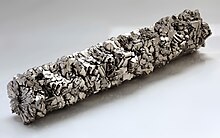Titanium, 22 Titanium Pronunciation Appearance sillery gray-white metallic Standard atomic weight A r, std (Ti) 7001478670000000000♠ 47.867(1)[ 2] Titanium in the periodic cairt
Atomic nummer (Z ) 22 Group group 4 Period period 4 Block d-block Element category Transeetion metal Electron confeeguration [Ar ] 3d2 4s2 Electrons per shell 2, 8, 10, 2 Pheesical properties Phase at STP solit Meltin pynt 1941 K (1668 °C, 3034 °F) Bylin pynt 3560 K (3287 °C, 5949 °F) Density (near r.t. ) 4.506 g/cm3 when liquid (at m.p. ) 4.11 g/cm3 Heat o fusion 14.15 kJ/mol Heat o vapourisation 425 kJ/mol Molar heat capacity 25.060 J/(mol·K) Vapour pressur
P (Pa)
1
10
100
1 k
10 k
100 k
at T (K)
1982
2171
(2403)
2692
3064
3558
Atomic properties Oxidation states −2, −1, 0,[ 3] +4 [ 4] amphoteric oxide) Electronegativity Pauling scale: 1.54 Ionisation energies 1st: 658.8 kJ/mol 2nd: 1309.8 kJ/mol 3rd: 2652.5 kJ/mol (more ) Atomic radius empirical: 147 pm Covalent radius 160±8 pm Colour lines in a spectral range Spectral lines o titaniumIther properties Naitural occurrence primordial Creestal structur hexagonal close-packed (hcp) Speed o soond thin rod 5090 m/s (at r.t. ) Thermal expansion 8.6 µm/(m·K) (at 25 °C) Thermal conductivity 21.9 W/(m·K) Electrical resistivity 420 nΩ·m (at 20 °C) Magnetic orderin paramagnetic Magnetic susceptibility +153.0·10−6 cm3 /mol (293 K)[ 5] Young's modulus 116 GPa Shear modulus 44 GPa Bulk modulus 110 GPa Poisson ratio 0.32 Mohs haurdness 6.0 Vickers haurdness 830–3420 MPa Brinell haurdness 716–2770 MPa CAS Nummer 7440-32-6 History Diskivery William Gregor (1791) First isolation Jöns Jakob Berzelius (1825) Named by Martin Heinrich Klaproth (1795) Main isotopes o titanium
| references
Titanium is a chemical element wi the seembol Ti an atomic nummer 22. It is a lustrous transeetion metal wi a siller colour, law density an heich strength. It is heichly resistant tae corrosion in sea watter , aqua regia an chlorine .
Titanium wis diskivert in Cornwall , Great Breetain , bi William Gregor in 1791, an wis named bi Martin Heinrich Klaproth efter the Titans o Greek meethologie . The element occurs within a nummer o meeneral deposits, principally rutile an ilmenite , that are widely distributit in the Yird's crust an lithosphere , an it is foond in awmaist aw leevin things, watter bouks, rocks, an siles.[ 6] Kroll [ 7] Hunter processes . The maist common compoond, titanium dioxide , is a popular photocatalyst an is uised in the manufactur o white pigments.[ 8] titanium tetrachloride (TiCl4 ), a component o smeuk screens an catalysts ; an titanium trichloride (TiCl3 ), that is uised as a catalyst in the production o polypropylene .[ 6]
Titanium can be alloyed wi airn , alumeenium , vanadium , an molybdenum , amang ither elements, tae produce strang, lichtwecht alloys for aerospace (jet ingines , missiles , an spacecraft ), militar, industrial processes (chemicals an petrochemicals, desalination plants , pulp, an paper), automotive, agri-fuid, medical prostheses , orthopedic implants , dental an endodontic instruments an files, dental implants , sportin guids, jewelry, mobile phones , an ither applications.[ 6]
The twa maist uisefu properties o the metal are corrosion resistance an strenth-tae-density ratio, the heichest o ony metallic element.[ 9] steels , but less dense.[ 10] allotropic forms[ 11] isotopes o this element, 46 Ti throu 50 Ti, wi 48 Ti bein the maist abundant (73.8%).[ 12] valence electrons an are in the same group in the periodic cairt , titanium an zirconium differ in mony chemical an pheesical properties.
↑ "titanium - definition of titanium in English | Oxford Dictionaries" . Oxford University Press. 2017. Retrieved 28 Mairch 2017 .↑ Meija, Juris; et al. (2016). "Atomic weights of the elements 2013 (IUPAC Technical Report)" . Pure and Applied Chemistry 88 (3): 265–91. doi :10.1515/pac-2015-0305 ↑ Jilek, Robert E.; Tripepi, Giovanna; Urnezius, Eugenijus; Brennessel, William W.; Young, Victor G., Jr.; Ellis, John E. (2007). "Zerovalent titanium–sulfur complexes. Novel dithiocarbamato derivatives of Ti(CO)6 : [Ti(CO)4 (S2 CNR2 )]− ". Chem. Commun. (25): 2639–2641. doi :10.1039/B700808B . PMID 17579764 . ↑ Andersson, N.; et al. (2003). "Emission spectra of TiH and TiD near 938 nm" (PDF) . J. Chem. Phys . 118 (8): 10543. Bibcode :2003JChPh.118.3543A . doi :10.1063/1.1539848 . ↑ Weast, Robert (1984). CRC, Handbook of Chemistry and Physics . Boca Raton, Florida: Chemical Rubber Company Publishing. pp. E110. ISBN 0-8493-0464-4 ↑ a b c "Titanium" . Encyclopædia Britannica . 2006. Retrieved 29 December 2006 .↑ Lide, D. R., ed. (2005). CRC Handbook of Chemistry and Physics (86th ed.). Boca Raton (FL): CRC Press. ISBN 0-8493-0486-5 ↑ Krebs, Robert E. (2006). The History and Use of Our Earth's Chemical Elements: A Reference Guide Westport, CT : Greenwood Press. ISBN 978-0-313-33438-2 ↑ Donachie 1988 , p. 11↑ Barksdale 1968 , p. 738↑ "Titanium" . Columbia Encyclopedia Columbia University Press . 2000–2006. ISBN 978-0-7876-5015-5 the original on 18 November 2011.↑ Barbalace, Kenneth L. (2006). "Periodic Table of Elements: Ti – Titanium" . Retrieved 26 December 2006 .


